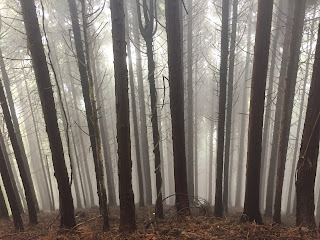The nice thing about having friends with diverse interests is that they often prompt you to try different things. So when my friend, who is also named Claire, suggested a group hike out of the city this Saturday I was excited to do something a little out of my normal weekend routine.
So perhaps a little earlier than I would have liked for a Saturday morning, I took a rather convoluted series of trains from my apartment to Mitake Station, just past the city of Ome in the western edge of Tokyo prefecture (yes, "Tokyo" is technically more than the metropolis proper).
Eschewing the cable car, we then began a rather misty hike up Mount Mitake, generally relishing in the cooler temperatures and the pervading scent of petrichor. There's nothing like some good ol' shinrin-yoku (lit. "forest bathing," it's a widely accepted form of nature therapy).
Once we crested the top of the mountain, we took a quick peek at Musashi-Mitake Shrine which, dating back to about 90 B.C., is presumed to be one of the oldest shrines in Japan. Of course the current buildings aren't from 90 B.C. Instead, they're faithful replicas, built in 1877, of the original structure.
From Musashino-Mitake Shrine we set off on a meandering 2-hour-long trek through the surrounding area. While not particularly strenuous in terms of the steepness of the path, many slippery steps of rock or tree roots made for a semicautious pace.
The second natural highlight was the so-called Rock Garden. Not your Kyoto-temple-manicured-garden, this was basically just a lush valley strewn with large moss-covered rocks and tree trunks. It felt like the kodama forest spirits from the Ghibli movie Princess Mononoke would pop out any minute!
So perhaps a little earlier than I would have liked for a Saturday morning, I took a rather convoluted series of trains from my apartment to Mitake Station, just past the city of Ome in the western edge of Tokyo prefecture (yes, "Tokyo" is technically more than the metropolis proper).
Eschewing the cable car, we then began a rather misty hike up Mount Mitake, generally relishing in the cooler temperatures and the pervading scent of petrichor. There's nothing like some good ol' shinrin-yoku (lit. "forest bathing," it's a widely accepted form of nature therapy).
Once we crested the top of the mountain, we took a quick peek at Musashi-Mitake Shrine which, dating back to about 90 B.C., is presumed to be one of the oldest shrines in Japan. Of course the current buildings aren't from 90 B.C. Instead, they're faithful replicas, built in 1877, of the original structure.
From Musashino-Mitake Shrine we set off on a meandering 2-hour-long trek through the surrounding area. While not particularly strenuous in terms of the steepness of the path, many slippery steps of rock or tree roots made for a semicautious pace.
Our walk had several natural highlights. The first was Nanayo Falls, a waterfall that poured down from the mountain into a sheltered pool. The water was icy cold and the entire clearing around the pounding water was cool. After marveling at the water and the rocks, we perched on the dryest boulders we could find and ate onigiri (rice balls), trail mix, and chocolate.
The final stop was another waterfall and reputed "power spot," Ayahirono Falls. Apparently it's used for classic waterfall training by mountain ascetics and monks.
Then, all that was left was make our way back to the peak (929 meters), catch one last glimpse of the misted valleys, and take the multicolored cable car (which is run by Keio, apparently) back down. Depressingly, the hike from the base to the Musashino-Mitake Shrine that took us the better part of an hour only took 6 minutes in the cable car...
 |
| This view looks out towards Tokyo. On clear days you can apparently see Tokyo Tower and/or the Tokyo Skytree from here! |
Until next time!
















I really enjoyed the quality information you offer to your visitors for this blog. I will bookmark your blog and have my friends check up here often. Ramen in St Paul
ReplyDelete